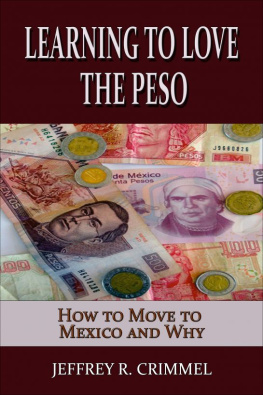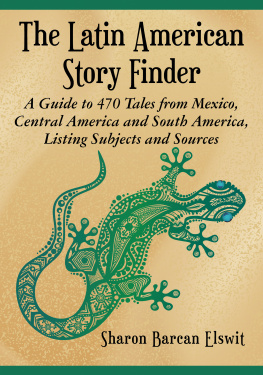Learning to Love the Peso

How to Move to Mexico and Why
Published by Jeffrey R. Crimmel atSmashwords
Copyright 2012 Jeffrey R. Crimmel
Smashwords Edition, License Notes
This ebook is licensed for your personalenjoyment only. This ebook may not be re-sold or given away toother people. If you would like to share this book with anotherperson, please purchase an additional copy for each recipient. Ifyou're reading this book and did not purchase it, or it was notpurchased for your use only, then please return to Smashwords.comand purchase your own copy. Thank you for respecting the hard workof this author.
Cover Design by Rita Toews
Contents
Prologue
So! Youre thinking of retirement and haveheard stories about living in some exotic town in a foreigncountry. Friends who have traveled tell you how inexpensive placesin Central America and Mexico are and there is even a maid to cleanthe house for almost nothing. For an added bonus Americans,Canadians and a few Brits are already living there.
Magazine publications at Barnes and Nobel arefull of tales about investing in these countries. How about buyinga house in a development with other Americans as your neighbor orhaving a home for your vacation and renting it out during the timesyou are not staying there sound? Does it seem too good to betrue?
The stories are accurate when describing theinexpensive life styles and the beauty each community holds. Thearticles are usually from the perspective of the real estate personwanting to get you to invest, build a house or buy a home alreadyfinished. There are no descriptions about making the move and thehurdles one faces when transporting all your belongings to adevelopment or town in a third world country.
Learning to Love the Peso is my tale of how Ifound my place in one of the many areas in Mexico where foreignershave moved to and changed their lives. An explanation of why Iwanted to move south of the border and all the steps needed to makethe transition are included throughout the book. An historicalperspective of why people move to warm climates in the winter ispresented as well. The present day migration, made by thousands ofpersons who call themselves Snowbirds, brings us to the locationswhere people move in their attempt to avoid the winters of theNorth. Much of the information about the historical migration wasdiscovered during my nine-year odyssey around the globe from 1970to 1979. "Living Beneath the Radar" is my first book describingthose adventures.
You will find the contents of the bookhelpful, interesting and hopefully dispel the views many Americanshave about third world cultures. Mexico is especially given anegative view as it is described in the news. The storiesconcentrate on the drug wars and killings in a few of the bordertowns along the Texas and Arizona borders. I have been told by manyfriends and acquaintances how bad Mexico is and living in a ThirdWorld Country is not all what it is stacked up to be. When I askthem if they have ever visited Mexico; not to my surprise, mostsaid no. They instead tell me about their local news channel wherethey heard these reports. Those who said they visited Mexicoacknowledge their "port of entry" from their cruise ships either inBaja or the mainland. They never got further than the guided toursand souvenir shops waiting for them in their protected environment.This experience would compare to taking a tour ship into SanFrancisco Bay, eating a meal at Fishermans Warf, buying a fewsweatshirts for the grandkids back in Germany, getting back onboard and sailing home. Can this person say they have seenAmerica?
This book includes many stories describingthe personal adventures encountered while making the move to Mexicoand the adjustments after relocating. The information andexperiences of this journey are written down within a day or two ofthem happening so the reader can join in with me on the adventure.Learning to Love the Peso is not just about the pleasant encountersduring the transition. Filling in the gaps of the fun stuff withthe difficult obstacles as well, gives the reader the hard factsabout such a move and the situations one has to navigate to makesuch a dramatic change happen. Learning to Love the Peso mayincrease your desire to make a metamorphosis in your lifestyle orcompletely wipe out any aspirations of living in the land ofsunshine. Believe me, such a move is not for everyone. Hang on andhold tight. The journey begins.
Chapter 1
June 2010
I mentioned at the end of Living Beneath theRadar my wife and I were going to be moving to Baja, Mexico whenwe were both retired. Suzanne was her mother's caretaker andmanages all her affairs. Medications, doctor visits, filing hertaxes and any other matters arising, Suzanne deals with. Whateverwas necessary to be done for a woman of 94 years, Suzanne carriedout the duty. Alice was no longer capable of these tasks due to herage and the difficulties accompanying most elder people. Caring fora parent is an involved, part-time job and it takes a lot of focusand energy to get these tasks completed.
We recently moved to the Phoenix valley fromFlagstaff after Suzanne retired in June of 2010. We moved hermother to Phoenix the month before and she now resides in a verynice home full of elderly people, many of whom have dementia.
My first visit to the home was indeed aninsight into a population not remembering the conversation they hadwith you ten minutes ago. As I sat in the room, enjoying the airconditioning cooling me from the 90+ degrees outside, I wasapproached by different ladies in the home who were curious as tohow I fit into their lives and why was I sitting in their home. Iexplained my connection with Alice in as much detail as I believedthey needed to satisfy their curiosity. In about ten or fifteenminutes the same woman would return to where I was sitting andstart the same inquiry all over again. The exact same questionswould be asked and I would again give her my answer. I was visitingthe world of Groundhog Day. The movie starring Bill Murray isabout living the same day over and over again until the star getsit right. I realized if I did not give all the information I wantedto give to the conversation the first time, all I had to do waswait. The opportunity would present itself again in a matter ofminutes when one of the ladies returned. This situation happenedeach time we visited the home where Alice lived, usually with thesame woman asking the questions.
Future visits taught me a little about thelife of women in a home for the elderly. A lot of their dailyroutine is centered around the meals served in the main room. Anhour before dinner the women started to appear in the main livingroom and found their seats on the couch and chairs near the diningtable. Each of the ladies knew who sat where.
Peggy sits on the end of the couch whileMildred likes to be at the table where she can snack on the cookiesbefore dinner.
Routine is an important part of the ladiesliving in the home and when a new arrival comes then a bit ofconfusion exist for a few days until the new seating chart isestablished. Alice was the rookie. She took whatever locationbecame available near the TV and dinning table.
Alice can have Sallys seat. She left usabout three weeks ago and is not expected back.
I believe the reference to Sally leaving andnot coming back meant she passed on but I did not hear the worddeath or died used much in the home. The women knew they wereold and the "end" could be near for some of them. They werecomfortable in the home they shared with each other, notremembering what happened the day before or even ten minutesbefore.











